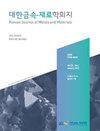机械合金化法制备立方晶Cu3Sb1-yFeyS3的相、晶体结构和热电性能
IF 1.4
4区 材料科学
Q4 MATERIALS SCIENCE, MULTIDISCIPLINARY
引用次数: 0
摘要
Skinnerite(Cu3SbS3)由于其低热导率而作为一种有前途的热电材料近年来引起了人们的关注。在本研究中,我们使用机械合金化和热压进行了Fe掺杂的skinnerite Cu3Sb1-yFeyS3(y=0.02−0.06)的固态合成,并检查了样品相对于Fe掺杂含量的热电性能。如X射线衍射所证明的,所有样品仅包含立方skinnerite相。随着Fe含量的增加,晶格常数从1.03370降低到1.03310nm,表明Fe在Sb位置的成功取代。载流子浓度随着Fe掺杂水平的增加而增加,导致电导率增加。y=0.02−0.04的样品表现出非简并半导体行为,其中电导率随着温度的升高而增加。相反,y=0.06的样品将导电行为改变为具有最小温度依赖性的简并态。随着Fe含量的增加,塞贝克系数降低,Cu3Sb0.98Fe0.02S3在623K时表现出1.16 mWm-1K-1的最大功率因数。在测量的温度范围内,所有样品的热导率值都低于1.20 Wm-1,但高于未掺杂的石皮矿。Cu3Sb0.98Fe0.02S3样品获得了最高的热电性能,在623K下获得了0.9的无量纲品质因数ZT。本文章由计算机程序翻译,如有差异,请以英文原文为准。
Phase, Crystal Structure, and Thermoelectric Performance of Cubic Skinnerite Cu3Sb1-yFeyS3 Synthesized by Mechanical Alloying
Skinnerite (Cu3SbS3) has recently attracted attention as a promising thermoelectric material because of its low thermal conductivity. In this study, we performed the solid-state synthesis of Fe-doped skinnerite Cu3Sb1-yFeyS3 (y = 0.02−0.06) using mechanical alloying and hot pressing, and examined the samples’ thermoelectric properties relative to Fe doping content. All samples contained only a cubic skinnerite phase, as evidenced by X-ray diffraction. As the Fe content increased, the lattice constant decreased from 1.03370 to 1.03310 nm, indicating successful substitution of Fe at the Sb sites. The carrier concentration increased with the Fe doping level, resulting in increased electrical conductivity. The specimens with y = 0.02− 0.04 exhibited non-degenerate semiconductor behavior, where the electrical conductivity increased as the temperature increased. In contrast, a specimen with y = 0.06 changed conduction behavior to the degenerate state with minimal temperature dependence. As the Fe content increased, the Seebeck coefficient decreased, and Cu3Sb0.98Fe0.02S3 exhibited a maximum power factor of 1.16 mWm-1K-2 at 623 K. Thermal conductivity values for all specimens were lower than 1.20 Wm-1K-1 in the measured temperature range but were higher than undoped skinnerite. The highest thermoelectric performance was achieved by the Cu3Sb0.98Fe0.02S3 specimen, with a dimensionless figure of merit, ZT, of 0.9 obtained at 623 K.
求助全文
通过发布文献求助,成功后即可免费获取论文全文。
去求助
来源期刊

Korean Journal of Metals and Materials
MATERIALS SCIENCE, MULTIDISCIPLINARY-METALLURGY & METALLURGICAL ENGINEERING
CiteScore
1.80
自引率
58.30%
发文量
100
审稿时长
4-8 weeks
期刊介绍:
The Korean Journal of Metals and Materials is a representative Korean-language journal of the Korean Institute of Metals and Materials (KIM); it publishes domestic and foreign academic papers related to metals and materials, in abroad range of fields from metals and materials to nano-materials, biomaterials, functional materials, energy materials, and new materials, and its official ISO designation is Korean J. Met. Mater.
 求助内容:
求助内容: 应助结果提醒方式:
应助结果提醒方式:


